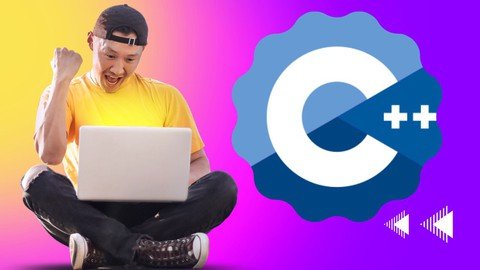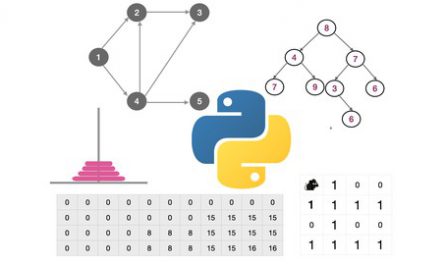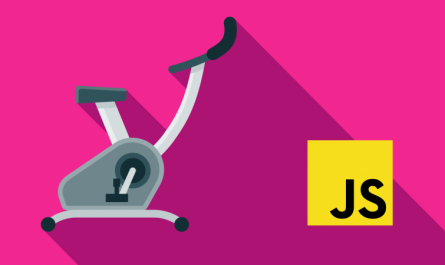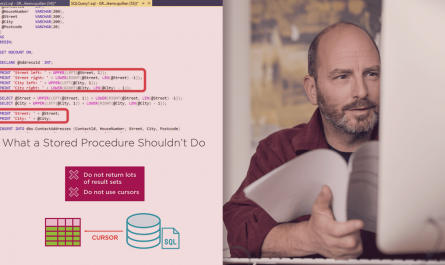
Description
Beginner Control Statements (10 Pts)Data Types and Operators (10 Pts)Print different Patterns(5 Pts)Functions (10 Pts)Arrays (5 Pts)String Manipulation (5 Pts)User-Defined Data Types (structs and enums) ( 5 Pts)Intermediate Pointers(12 Pts)Classes and Objects (10 Pts)Inheritance (8 Pts)Polymorphism (6 Pts)Abstraction (4 Pts)Exception Handling (6 Pts)File Handling (10 Pts)Operator overloading (4 Pts)Advanced Templates (12 Pts)Data Structures (12 Pts)STL (Standard Template Library) (9 Pts)Smart Pointers(6 Pts)Multithreading (6 Pts)Networking (3 Pts)Signal Handling (3 Pts)Dynamic allocation and deallocation (3 Pts)Inline function (3 Pts)Friend function (3 Pts)Welcome to “Practice C++ with 100 C++ Exercises”! In this course, you will enhance your C++ programming skills by solving 100 diverse C++ assignments on your own. The assignments vary in difficulty, ranging from easy to advanced, and each assignment includes a solution provided by the instructor so that you can compare your code with theirs. This course is suitable for individuals who have a basic understanding of C++ programming fundamentals, such as variables, data types, functions, loops, and conditionals. If you are new to C++ programming, we recommend taking a beginner’s course before enrolling in this one. Additionally, the course includes brief and succinct videos that cover essential C++ concepts related to the exercises. As you progress through the exercises, they will become progressively more challenging. The topics covered by the exercises are extensive and broad-ranging. You will encounter problems like creating a simple calculator, implementing data structures, designing games, debugging existing programs, and building GUI applications. The extensive variety of exercises will help improve your C++ programming abilities in all critical areas. This course will also increase your confidence when applying for programming jobs. The abilities you acquire in this course are frequently asked about in C++ programming job interviews. As a result, you will be well-prepared for such interviews and have a competitive advantage in the job market.
Overview
Section 1: Course Introduction
Lecture 1 Introduction
Section 2: Control Statements (10 Pts)
Lecture 2 Exercise 1 – Nested for loop
Lecture 3 Exercise 1 – Solution
Lecture 4 Exercise 1 – Explanation
Lecture 5 Exercise 2 – If…else
Lecture 6 Exercise 2 – Solution
Lecture 7 Exercise 2 – Explanation
Lecture 8 Exercise 3 – Switch
Lecture 9 Exercise 3 – Solution
Lecture 10 Exercise 3 – Explanation
Lecture 11 Exercise 4 – Nested If
Lecture 12 Exercise 4 – Solution
Lecture 13 Exercise 4 – Explanation
Lecture 14 Exercise 5 – While
Lecture 15 Exercise 5 – Solution
Lecture 16 Exercise 6 – Do While
Lecture 17 Exercise 6 – Solution
Lecture 18 Exercise 7 – Continue
Lecture 19 Exercise 7 – Solution
Lecture 20 Exercise 8 – Armstrong number(While Loop)
Lecture 21 Exercise 8 – Solution
Lecture 22 Exercise 9 – Fibonacci Series (for loop)
Lecture 23 Exercise 9 – Solution
Lecture 24 Exercise 10 – Prime Number
Lecture 25 Exercise 10 – Solution
Section 3: Data types and Operators(10 Pts)
Lecture 26 Exercise 1 – Data Type
Lecture 27 Exercise 1 – Solution
Lecture 28 Exercise 2- Simple Interest
Lecture 29 Exercise 2- Solution
Lecture 30 Exercise 3 – Average of 3 numbers
Lecture 31 Exercise 3 – Solution
Lecture 32 Exercise 4 – Ternary operator.
Lecture 33 Exercise 4 – Solution
Lecture 34 Exercise 5 – Bitwise operators
Lecture 35 Exercise 5 – Solution
Lecture 36 Exercise 6 – Celsius to Fahrenheit
Lecture 37 Exercise 6 – Solution
Lecture 38 Exercise 7 – Arithmetic operations
Lecture 39 Exercise 7 – Solution
Lecture 40 Exercise 8 – Pre-increment and Post-decrement operators.
Lecture 41 Exercise 8 – Solution
Lecture 42 Exercise 9 – Relational operators
Lecture 43 Exercise 9 – Solution
Lecture 44 Exercise 10 – Logical Operators
Lecture 45 Exercise 10 – Solution
Section 4: Print different Patterns (5 Pts)
Lecture 46 Exercise 1 – Square Pattern
Lecture 47 Exercise 1 – Solution
Lecture 48 Exercise 2 – Left triangle star pattern
Lecture 49 Exercise 2 – Solution
Lecture 50 Exercise 3 – Right triangle star pattern
Lecture 51 Exercise 3 – Solution
Lecture 52 Exercise 4 – Pyramid star pattern
Lecture 53 Exercise 4 – Solution
Lecture 54 Exercise 5 – Diamond star pattern
Lecture 55 Exercise 5 – Solution
Section 5: Functions (10 Pts)
Lecture 56 Exercise 1 – Functions
Lecture 57 Exercise 1 – Solution
Lecture 58 Exercise 2 – Number of Vowels and Consonants using function
Lecture 59 Exercise 2 – Solution
Lecture 60 Exercise 3- Function with Return type
Lecture 61 Exercise 3 – Solution
Lecture 62 Exercise 4 – Return type with argument
Lecture 63 Exercise 4 – Solution
Lecture 64 Exercise 5 – Call by Value
Lecture 65 Exercise 5 – Solution
Lecture 66 Exercise 6 – Call by Reference
Lecture 67 Exercise 6 – Solution
Lecture 68 Exercise 7 – Find the Factorial(Recursion)
Lecture 69 Exercise 7 – Solution
Lecture 70 Exercise 8 – nth Fibonacci number(Recursion)
Lecture 71 Exercise 8 – Solution
Lecture 72 Exercise 9 – Sum of the digits of a number(Recursion)
Lecture 73 Exercise 9 – Solution
Lecture 74 Exercise 10 – Reverses a string(Recursion)
Lecture 75 Exercise 10 – Solution
Section 6: Arrays (5 Pts)
Lecture 76 Exercise 1 – Sum of all elements in an array of integers
Lecture 77 Exercise 1 – Solution
Lecture 78 Exercise 2 – Largest element in the array.
Lecture 79 Exercise 2 – Solution
Lecture 80 Exercise 3 – Reverse an array of integers.
Lecture 81 Exercise 3 – Solution
Lecture 82 Exercise 4 – Remove duplicates from an array of integers.
Lecture 83 Exercise 4 – Solution
Lecture 84 Exercise 5 – Sort an array of integers in ascending order
Lecture 85 Exercise 5 – Solution
Section 7: String Manipulation (5 Pts)
Lecture 86 Exercise 1 – String Length without using any library functions
Lecture 87 Exercise 1 – Solution
Lecture 88 Exercise 2 – Copy one String into another String without using library function
Lecture 89 Exercise 2 – Solution
Lecture 90 Exercise 3 – String manipulation using library functions
Lecture 91 Exercise 3 – Solution
Lecture 92 Exercise 4 – Palindrome
Lecture 93 Exercise 4 – Solution
Lecture 94 Exercise 5 – Capitalizes the first letter of every word
Lecture 95 Exercise 5 – Solution
Section 8: User-Defined Data Types (structs and enums)
Lecture 96 Exercise 1 – Struct
Lecture 97 Exercise 1 – Solution
Lecture 98 Exercise 2 – Struct and Function
Lecture 99 Exercise 2 – Solution
Lecture 100 Exercise 3 – Enum
Lecture 101 Exercise 3 – Solution
Lecture 102 Exercise 4 – Enum and Switch
Lecture 103 Exercise 4 – Solution
Lecture 104 Exercise 5 – typedef
Lecture 105 Exercise 5 – Solution
Section 9: Pointers(12 Pts)
Lecture 106 Exercise 1 – Pointer Basics
Lecture 107 Exercise 1 – Solution
Lecture 108 Exercise 2 – Swap Using Pointers
Lecture 109 Exercise 2 – Solution
Lecture 110 Exercise 3 – Pointer Arithmetic
Lecture 111 Exercise 3 – Solution
Lecture 112 Exercise 4 – Pointer and Function
Lecture 113 Exercise 4 – Solution
Lecture 114 Exercise 5 – Pointers to Pointers.
Lecture 115 Exercise 5 – Solution
Lecture 116 Exercise 6 – Pointers and Objects
Lecture 117 Exercise 6 – Solution
Section 10: Classes and Objects
Lecture 118 Exercise 1 – Defining Class
Lecture 119 Exercise 1 – Solution
Lecture 120 Exercise 2 – Multiple Objects
Lecture 121 Exercise 2 – Solution
Lecture 122 Exercise 3 – Class Methods
Lecture 123 Exercise 3 – Solution
Lecture 124 Exercise 4 – Constructors
Lecture 125 Exercise 4 – Solution
Lecture 126 Exercise 5 – Constructor Parameters
Lecture 127 Exercise 5 – Solution
Section 11: Inheritance (8 Pts)
Lecture 128 Exercise 1 – Single Level Inheritance
Lecture 129 Exercise 1 – Solution
Lecture 130 Exercise 2 – Multi Level Inheritance
Lecture 131 Exercise 2 – Solution
Lecture 132 Exercise 3 – Multiple Inheritance
Lecture 133 Exercise 3 – Solution
Lecture 134 Exercise 4 – Protected access specifier
Lecture 135 Exercise 4 – Solution
Section 12: Polymorphism (6 Pts)
Lecture 136 Exercise 1 – Compile-time polymorphism(Function Overloading)
Lecture 137 Exercise 1 – Solution
Lecture 138 Exercise 2 – Run-time Polymorphism(Function Overriding)
Lecture 139 Exercise 2 – Solution
Lecture 140 Exercise 3 – Virtual function
Lecture 141 Exercise 3 – Solution
Section 13: Abstraction (4 Pts)
Lecture 142 Exercise 1 – Interface
Lecture 143 Exercise 1 – Solution
Lecture 144 Exercise 2 – Data abstraction using classes
Lecture 145 Exercise 2 – Solution
Section 14: Exception Handling (6 Pts)
Lecture 146 Exercise 1 – Divide by Zero Exception
Lecture 147 Exercise 1 – Solution
Lecture 148 Exercise 2 – Invalid Input Exception
Lecture 149 Exercise 2 – Solution
Lecture 150 Exercise 3 – File Not Found Exception
Lecture 151 Exercise 3 – Solution
Section 15: File Handling (10 Pts)
Lecture 152 Exercise 1 – create a file and write text into it.
Lecture 153 Exercise 1 – Solution
Lecture 154 Exercise 2 – Read File and Display on Screen
Lecture 155 Exercise 2 – Solution
Lecture 156 Exercise 3 – Copy the contents of one file into another file
Lecture 157 Exercise 3 – Solution
Lecture 158 Exercise 4 – Count the number of words in a file
Lecture 159 Exercise 4 – Solution
Lecture 160 Exercise 5 – Sort the contents of a file alphabetically.
Lecture 161 Exercise 5 – Solution
Section 16: Operator overloading (4 Pts)
Lecture 162 Exercise 1 – Basic Arithmetic Operator Overloading
Lecture 163 Exercise 1 – Solution
Lecture 164 Exercise 2 – overloading the operator (++ & –)
Lecture 165 Exercise 2 – Solution
Section 17: Templates (12 Pts)
Lecture 166 Exercise 1 – Function Templates
Lecture 167 Exercise 1 – Solution
Lecture 168 Exercise 1 – Class Template
Lecture 169 Exercise 2 – Solution
Lecture 170 Exercise 3 – Calculate the average of any number of values
Lecture 171 Exercise 3 – Solution
Lecture 172 Exercise 4 – Minimum value in an array of any data type
Lecture 173 Exercise 4 – Solution
Section 18: Data Structures (12 Pts)
Lecture 174 Exercise 1 – Stack using a linked list
Lecture 175 Exercise 1 – Solution
Lecture 176 Exercise 2 – Queue using a linked list
Lecture 177 Exercise 2 – Solution
Lecture 178 Exercise 3 – Doubly linked list
Lecture 179 Exercise 3 – Solution
Lecture 180 Exercise 4 – Binary Search Tree
Lecture 181 Exercise 4 – Solution
Section 19: STL (Standard Template Library) (9 Pts)
Lecture 182 Exercise 1 – Vector
Lecture 183 Exercise 1 – Solution
Lecture 184 Exercise 2 – STL Algorithm
Lecture 185 Exercise 2 – Solution
Lecture 186 Exercise 3 – STL Algorithm Partition
Lecture 187 Exercise 3 – Solution
Section 20: Smart Pointers(6 Pts)
Lecture 188 Exercise 1 – Generic smart pointer class
Lecture 189 Exercise 1 – Solution
Lecture 190 Exercise 2 – unique_ptr
Lecture 191 Exercise 2 – Solution
Section 21: Multithreading (6 Pts)
Lecture 192 Exercise 1 – Multithreading
Lecture 193 Exercise 1 – Solution
Lecture 194 Exercise 2 – Producer-Consumer scenario using two threads
Lecture 195 Exercise 2 – Solution
Section 22: Networking (3 Pts)
Lecture 196 Exercise 1
Lecture 197 Exercise 1 – Solution
Section 23: Signal Handling (3 Pts)
Lecture 198 Exercise 1
Lecture 199 Exercise 1 – Solution
Section 24: Dynamic allocation and deallocation (3 Pts)
Lecture 200 Exercise 1
Lecture 201 Exercise 1 – Solution
Section 25: Inline function (3 Pts)
Lecture 202 Exercise 1
Lecture 203 Exercise 1 – Solution
Section 26: Friend function (3 Pts)
Lecture 204 Exercise 1
Lecture 205 Exercise 1 – Solution
Who this Course is For:
- People who know C++ basics, but lack the confidence to solve coding problems on their own.
Requirements
- A working computer (Windows, Mac, or Linux).
- Basic knowledge of C++
Last Updated 2/2023
Download Links
Direct Download
Practice C++ With 100 C++ Exercises.zip (158.0 MB) | Mirror
Torrent Download
Practice C++ With 100 C++ Exercises.torrent (55 KB) | Mirror


